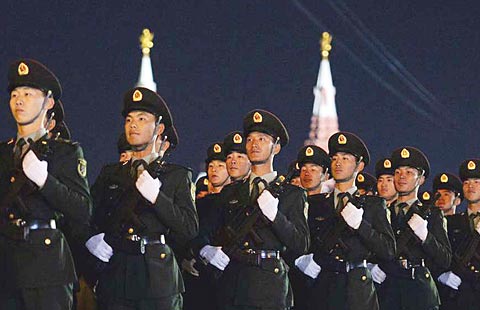
21st century collaboration can provide new asian source of global economic growth
Most people know how China became linked thousands of years ago with the Mediterranean and Europe through the Silk Road, a 6,500-kilometer trading route stretching across Central Asia. But not many people may know that a series of Chinese initiatives is bringing new life and vigor to these old central Asian trading posts.
Mirroring a diplomatic initiative undertaken 2,000 years ago by China's powerful Han emperor Wu Di, in 2013 Chinese President Xi Jinping and Premier Li Keqiang made visits to countries west of China, including Turkmenistan, Kazakhstan, Uzbekistan, Kyrgyzstan; all of the countries lying along the eastern end of the old trading route.
Today, although the extension of China's influence along the ancient Silk Road still depends on the powerful pull of East-West trade, today it is not spices, gold or beautiful women from Central Asia that interest China.
Countries around the Caspian Sea, including Iran and Kazakhstan, account for more than one-third of global reserves of natural gas, and more than 10 percent of oil reserves. But China is looking outward beyond the security of its energy supplies.
A speech by Xi in September 2013 gave the first hint of an idea that has the potential to provide a new Asian source of global economic growth and multicultural understanding.
The president proposed a new 21st century collaboration stretching from Europe through the Middle East and Asia to China based on the ancient trading relationships between China and its western neighbors. The idea has expanded in scope since 2013, and is now referred to as the One Belt, One Road initiative.
The 21st Century Maritime Silk Road stretches from China's east coast, linking south to Indonesia, west through ports in Singapore, Malaysia, Myanmar, Bangladesh and Sri Lanka, then to Africa's east coast at Mombasa, and through the Suez Canal to Greece in southern Europe.
The Silk Road Economic Belt is overland, with a northern branch through Kazakhstan linking Moscow to Poland and onto Western Europe, and a southern route through Iran, Iraq and Turkey to the Mediterranean. The belt and road concept involves 60 countries, most of them emerging economies, and together they account for more than 60 percent of the global population. The concept builds on several trends.
One is economic: China is a huge manufacturing base that can spread component production and manufacturing processes around many Asian countries with varying skills and cost bases. Recent speeches by Xi have emphasized the potential for China-led economic development of the region. Including Iran (but not Russia or Iraq), Central Asia west of China's Xinjiang Uygur autonomous region is home to more than 160 million people. Yet its GDP is only $60 billion in purchasing-power terms - smaller than most Chinese provinces.
The potential for growth is obvious. A new economic hub based on western and Central China, stretching west to the Caspian Sea and beyond, would be a game-changer both for China and countries throughout Asia, from east to west. India would also be a major beneficiary.
Economic development would bring prosperity and stability once again to a Central Asian region associated with poverty and decline since the Silk Road's importance diminished about 500 years ago. China already runs large trade deficits with most other Asian countries. It would be natural for China's currency to be used as the main currency along the new Silk Road, much as Chinese copper coins could be found all along the route 2,000 years ago, promoting the role of yuan as a global currency.
Another trend is the need to enhance regional security and economic development in a part of the world where Muslim extremism and nationalist unrest create potential for global instability. Developed European countries have welcomed China's interest in the new Silk Road, as they need new sources of economic growth and lack the long-embedded local relationships and understanding that could bring lasting peace to Central Asia.
The Shanghai Cooperation Organization, formed by China and Russia in the mid-1990s to resolve Central Asian border disputes, has brought important issues of diplomacy and security to this Central Asian dialogue, which are of increasing interest to countries on the periphery, such as Pakistan, Turkey and even Sri Lanka. The One Belt, One Road initiative will broaden and deepen this process.
The vulnerability of China's seaborne trade links, which narrow to a channel just kilometers wide in the Straits of Malacca near Singapore, create another strong incentive for China to create overland trade links with the West. The US computer and printer manufacturer Hewlett-Packard finds it faster and cheaper to ship equipment made in Chinese factories on the three-week overland route from Chengdu, in western Sichuan province, to Germany, rather than taking the sea route.
In a few years, it will be possible to ship containers overland from a range of transport hubs in eastern and western China to destinations and ports throughout Europe, at a fraction of the price and a fraction of the time taken by seaborne traffic.
China has backed the belt and road concept with a $40 billion Silk Road Fund and a new financing vehicle, the Asian Infrastructure Investment Bank, which until last month was a non-controversial effort to link Asian countries with a common purpose. Applications in March to join the new bank from major European developed countries have given the AIIB and the One Belt, One Road initiative a global scope, which currently does not include North America.
The participation of Britain, Germany, France, Italy and Spain as founding shareholders in the AIIB shows that the new Silk Road routes will benefit Europe as much as the first one did. The AIIB will help support huge investments in roads, railways, electricity and telecommunications, which are sorely needed in western and central parts of Asia.
In the early and middle years of the century's first decade, China's emergence created a resources boom that transformed the economic and social fortunes of many emerging countries in South Americ and Africa. Today, China's involvement in the new Silk Road projects will have a large effect on many countries with ancient and rich cultures as well as economies and societies longing for development.
The author is a visiting professor at Guanghua School of Management, Peking University.
(China Daily Africa Weekly 05/08/2015 page9)







